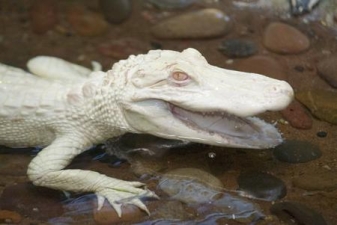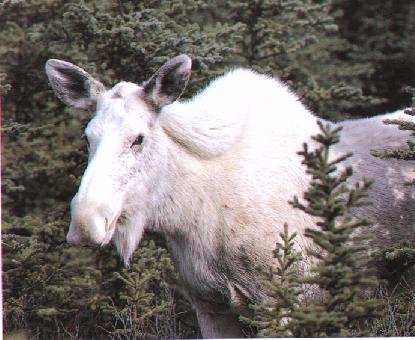Hot or Not Zoo Whites
Posted by: Loren Coleman on January 7th, 2008

Seven albino alligators were stolen from the only zoo run by the Federal University of Mato Grosso (UFMT) in Brazil as last year came to a close.
Biologist Itamar Assumpcao, who is in charge of the administration of the zoo, told the media during the first week of 2008 that the alligators were last seen on December 31, 2007.
The federal police are investigating whether any staff member was involved in the theft. The alligators are suspected to be stolen for trade abroad. The total value of the animals, approximately two years old, was estimated to be 119,000 reais (68,000 U.S. dollars) in the illegal market.
The theft left the UFMT zoo with only one alligator that is 100 % albino, and 43 others that have smaller percentages of albinism in their genetic constitutions.

The albino alligators, born in 2005, are the result of 10 years of inbreeding that began shortly after a breeder sent the zoo a male and female alligator that were much lighter than their normal dark green color.

The UFMT zoo hosts 800 animals of 79 species in an area of 11 hectares.
Albino alligators are found in the midwestern states of Mato Grosso and Mato Grosso do Sul, as well as the northeastern states of Maranhao and Piaui. More than 50 endangered species find their habitat in Mato Grosso.
Two other reportedly albino alligators are currently at the Sao Paulo Aquarium in Brazil.
In the United States, white alligators are mostly famously located at the The Audubon Zoo in New Orleans (part of the Audubon Nature Institute). They were placed on exhibition when in 1987 an alligator nest was discovered with 18 freshly hatched alligators with white hides, due to a mutation termed leucism (they are not albino).
The Audubon Zoo’s “Swamp Exhibit” houses the leucistic alligators, which during the time I visited before Katrina, also contained a taller-than-human-sized model of the “Honey Island Swamp Monster.”
White (leucistic) alligators have been loaned to other zoos from the Audubon Zoo, for example, to the Hogle Zoo in Salt Lake City, the San Francisco Zoo, the Los Angeles Zoo, Bridgeport, CT’s Beardsley Zoo, the Knoxville Zoo, and others.
Omaha, Nebraska’s Henry Doorly Zoo in November 2006 placed on exhibition a white (leucistic) alligator, a 19-year old, 8-foot long, 180 pound male, as a new attraction. Considering it was 19 years old, that would make it one of the 1987 batch from the Audubon Zoo.
The Columbia, South Carolina’s Riverbanks Zoo also exhibits one white alligator. Riverbanks got their rare gator after SC’s Natural Resources Department agents seized three of the animals when three men were arrested in 2003 for taking the endangered species from the banks of a pond on Hilton Head Island. The other two gators died from an infection suffered before they were taken to the zoo.
Albino and white alligators remain rare in exhibitions, and a big draw for zoological park visitors.

White and albino animals of any species are hot exhibition items, as was discovered during the 1960s and 1970s with the explosion of white tiger exhibitions around the world. Mohan, the father of the white tigers of Rewa, was captured as a cub in 1951, and one of his offspring was presented to President Eisenhower in 1960. Tony, born in July of 1972 in the Circus Winter Quarters of the Cole Bros. Circus in Peru, Indiana, was the founder of many American white tiger lines, especially those used in circuses. The two lines crossed and crisscrossed in America. For example, over 70 white tigers were born at the Cincinnati Zoo, which is no longer in the white tiger business. Siegfried & Roy bought a litter of three white cubs from the Cincinnati Zoo. Today, white tiger breeding has diminished, but the animals remain publicly popular.
White moose are rarely seen and shown, and yet may relate to the cryptid phantom “ghost moose” accounts discussed here before.
White bison have sacred meanings and ponderings on them are more suited for another day.
Are zoo whites still hot or not? Certainly, these Brazilian albino alligators are now, unfortunately.

Source: Xinhua, January 3, 2008, other wire reports, various reference works, and personal observations.
About Loren Coleman
Loren Coleman is one of the world’s leading cryptozoologists, some say “the” leading living cryptozoologist. Certainly, he is acknowledged as the current living American researcher and writer who has most popularized cryptozoology in the late 20th and early 21st centuries.
Starting his fieldwork and investigations in 1960, after traveling and trekking extensively in pursuit of cryptozoological mysteries, Coleman began writing to share his experiences in 1969. An honorary member of Ivan T. Sanderson’s Society for the Investigation of the Unexplained in the 1970s, Coleman has been bestowed with similar honorary memberships of the North Idaho College Cryptozoology Club in 1983, and in subsequent years, that of the British Columbia Scientific Cryptozoology Club, CryptoSafari International, and other international organizations. He was also a Life Member and Benefactor of the International Society of Cryptozoology (now-defunct).
Loren Coleman’s daily blog, as a member of the Cryptomundo Team, served as an ongoing avenue of communication for the ever-growing body of cryptozoo news from 2005 through 2013. He returned as an infrequent contributor beginning Halloween week of 2015.
Coleman is the founder in 2003, and current director of the International Cryptozoology Museum in Portland, Maine.










White Lions are at the Philadelphia Zoo.
The Assiniboine Park Zoo in Winnipeg has a white Black Bear in it’s collection. It was orphaned when it’s mother was hit and killed by a car just west of Easterville Manitoba . It is not albino, just a white color phase Black Bear. There were reports of white Black Bears from the Sandilands Provincial Forest, south-east Manitoba, a number of years back.
The Houston Zoo also has a white alligator. I believe it is from Louisiana, and I may be wrong, but I think it is also from the same clutch as the other Audubon gators. I have some friends formerly employed with the zoo, I will inquire with them. It is beautiful to see in person, just so odd looking, yet amazingly beautiful.
I remember when the Houston Zoo first got the albino alligator. My family and I made a special trip just to see it and even as an adult (before kids) I would go because I loved the reptile exhibit. Unfortunately we don’t live near Houston anymore and the Houston Zoo is still my favorite. Don’t get me wrong, I love the zoo here in Pueblo and take my kids there regularly, but there is nothing like an albino alligator. Nothing.
I’d say the normal color of a full grown alligator is dark gray or blackish, not dark green. I’ve never seen a true albino gator, but I’ve seen the white ones at the zoo and aquarium in New Orleans many times, so much so that I don’t even consider them that strange looking anymore!
Another one of the white alligators from the 1987 Louisiana clutch is on display at the Audubon Aquarium of the Americas in New Orleans. It’s located in the Mississippi River Gallery section of the Aquarium.
I agree with CMGRACE.
Nothing like an albino alligator.
White Tigers, too.
I saw a white spectacled cobra. Gorgeous. Looked like it was sculpted out of ivory.
Whoever stole the white gators is probably looking for a sale on the animal market. But the white gators are going to be in the herpetocultural world like the Mona Lisa is in the art world. You may “own it” once you buy it from the thief, but you can never share it and let anyone know that you have it.
The Shark Reef at Mandalay Bay Casino in Las Vegas also has white alligators but I don’t know if they are leucids or true albinos
I know that it is fashionable among many of the more rabid animal-rights activists to want to ban breeding for aberrant coat colors (they seem to be especially averse to white). I know why they say that. It’s true that many of the first white tigers were crippled, cross-eyed, and had other conditions that are associated with inbreeding. Some deformed white tigers still occur from time to time, through indiscrimate inbreeding, and their birth defects can be horrendous.
Another argument against having aberrant color forms is that they take space and use resources that could be used for normally colored animals of the endangered species.
I understand why some people are against aberrant colored animals as zoo attractions, but I do not agree. I personally don’t have a problem with responsible zoos breeding aberrant coat colors, provided that the animals are well cared for and not sold as ”pets”, and that the normally-colored offspring are given the same care. Tracing the heredity of aberrant colors and patterns can tell us something about how colors and patterns become established within small populations. Aberrant color patterns that occur from time to time also give us some ideas of what type of patterning and/or coloring is possible with a species, and can point to what some related but now-extinct species may have looked like.
Besides, I like novelty as much as any other human. I love to go to zoos and it’s a bonus when there are unusually colored animals to see 🙂 .
Sure, it’s not feasible to release off-colored animals into the wild – but then, it’s generally not feasible to release any captive-bred animals into the wild. As zoo animals they do fine, though, and because of the human love of novelty, people will go to zoos just to see them. They may go to the zoo time and time again to see the white tigers or the king cheetahs or the white gators or whatever, but those same people usually to want to learn more about that species in general, and to support conservation programs.
The important thing that must be stressed is that the aberrantly colored animals are just that – aberrant. They shouldn’t be referred to as ”Royal” this or ”Rare” that – they are anomalies and they should be presented as such. There is no wild ”breed” of Rare Golden Tabby Tiger, nor is there any such thing as a Royal White Bengal Tiger.
Despite all the shrill screaming about aberrants being ”unnatural”, however, they do occur from time to time in the wild, and sometimes, as seems to be the case with blue or white bears and king cheetahs for example, the odd coloring does not seem to affect their survival at all. I believe that even white tigers born in the wild could survive about as well as colored tigers. They still have stripes to break up the body outline, and most prey animals alert to movement, not to color.
If conditions are right they can live to reproduce and thus pass on the trait. It’s feasible to imagine that under some circumstances aberrant colors can become a sizable part of the general species population, as in the case of melanistic color phases in various species of cats.
The sad thing is, that given the fractured state of most species’ natural habitat today, there’s not much chance that either aberrantly colored animals or their normally colored brethren will even continue to exist and evolve, except in zoos, game parks, and other types of captivity.
If I remember right the albino alligator at the Houston Zoo was taken from eggs that were found in the wild in Louisiana. And I agree, as long as those who breed them for the unnatural coloring or whatever treat the animals with great care I see no problem with it.
“Blanco” is the male leucistic alligator at the Houston Zoo. He along with his 17 other brothers (alligator sex gender is determined by temperature of the nest) were discovered on property in Louisiana, and then cared for by the Audubon Nature Institute. Some have even traveled the country on exhibit. Blanco is a permanent resident at the Houston Zoo.
There is a beautiful white alligator on display in a very naturalistic habitat at the Knoxville Zoo too.
There are also a number of white lions at the Cincinnati Zoo, including two beautiful full grown males who are brothers. I’ve been photographing those two since before they even had their manes. They are much more white as cubs than they are as adults. When adult, they’re not snowy white, but more of a very pale beige color, like cream with a little coffee poured in. The zoo has a partnership with Siegfried & Roy.
Cincy still has white tigers, too, but I don’t know whether they breed them now.